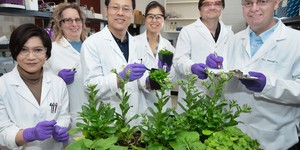Abstract
Do you like to climb trees? The branches of trees are what make them so fun to climb. Each branch starts out as a tiny shoot that grows out from a stem. How is the growth of shoots along a stem regulated?Summary
Objective
Test if growth of shoots along a plant stem is regulated.Introduction
Plants have two different types of stems, the main stem, called the apical stem, and the side stems, called lateral stems. The apical stem extends all the way from the roots to the tip of the plant. The lateral stems branch off from the main stem in regular intervals. On a tree, the apical stem would be the trunk, while the lateral stems would be the branches that you climb up on.
Stems branch in a regular pattern along the main stem. Watch this time-lapse video to see how the lateral stems in a plant branch off from the apical stem at regular intervals.
Each place where a lateral stem branches off of the main apical stem is called a node. Each node has a place where a new stem can grow from a bud. The bud contains special cells that can grow and become a new stem with leaves and flowers.
Why don't branches grow randomly along the stem? Why aren't there branches all along the stem? Branching and growth of lateral stems is a process that is regulated. This means that it is carefully controlled by the plant, sometimes it is turned off and sometimes growth is turned on. How is this growth regulated?
In this experiment, you will use mint plants to find out how stem growth and branching are regulated. Which parts of the plant are important? Are hormones involved? Are some parts of the plant dominant over other parts of the plant?
Terms and Concepts
- Apical shoot meristem
- Lateral shoot meristem
- Node
- Apical dominance
- Inhibition
- Bud
Bibliography
- Stack, Greg, et. al. (n.d.). The Great Plant Escape. University of Illinois Extension. Retrieved March 9, 2012.
- VanCleave, Janice. 1993. Janice VanCleave's A+ Projects in Biology. New York, NY: John Wiley & Son's Inc.
- Hangarter, R. (n.d.). A rosette by any other name. Plants-In-Motion. Retrieved March 9, 2012.
- Phoenix Bioinformatics. (n.d.). About Arabidopsis. Retrieved October 27, 2017.
Materials and Equipment
- Big bushy mint plant
- 5 small glass jelly jars
- Water
- Permanent marker
- Sunny window ledge
- Auxin (often called rooting hormone at your nursery)
Experimental Procedure
- Find a big bushy plant from the mint family. It can be any type of mint: spearmint, catnip, lemon balm, etc. A good place to look are in damp locations around walls and fences.
- Pull up five good sized plants with five or six good sized lateral stems on them. A good sized plant will be over 10 inches in length and have a good hardy main stem. Plants may be connected by underground runners, or connecting roots, which can be cut apart.
- Bring the plants inside and put each one in a jar, leaving the roots intact. Fill each jar with enough water to cover the roots.
- Take your first plant and label the jar "control" using a permanent marker. You will leave this plant alone and keep it with your other plants.
- You will remove all of the lateral stems from the other plants, being careful to leave the roots intact. When you are finished, each plant should look like one long stem with small bumps on the sides where the lateral stems used to be.
- Take one of these plants and label the jar "lateral stems removed" using a permanent marker. You will not do anything else to this plant.
- Take another plant and label the jar "lateral and apical stems removed" using a permanent marker.
- Using scissors cut off the tip of the plant down to the top of the first node, or branching point, of the main stem.
- Take another plant and label the jar "lateral and apical stems removed and auxin added" using a permanent marker.
- Using scissors cut off the tip of the plant down to the top of the first node on the main stem, just like you did on the previous plant. Immediately after cutting the tip off, dip the cut tip of the plant into the auxin, or rooting hormone powder.
- Take the last plant and label the jar "all stems removed" using a permanent marker.
- Using scissors cut off the entire stem portion of the plant, all the way down to the top of the roots and leaving about one inch of the main stem.
- Place all of the plants in a sunny window for one or two weeks. Make observations of the plants every 2–3 days and write them in a notebook. For each observation, write down the date, name of the plant, a written description of what you see and draw a picture.
- After two weeks, you should take a picture of each plant for your poster.
- What happened to the stems of each plant? Where did the new stem grow? Did all of the plants make new stems? Which plants did not? What do you think is similar between the plants that did not make stems? What does this tell you about how stem growth is regulated?
Ask an Expert
Global Connections
The United Nations Sustainable Development Goals (UNSDGs) are a blueprint to achieve a better and more sustainable future for all.
Variations
- Mint plants are not the only plants that regulate stem growth this way. Try this experiment on different plants in the garden. You don't even need to uproot the plants, you can keep them right in the garden. Make a tag for each experimental stem using masking tape. Fold the masking tape around the stem, sticking the ends together to make a tag. Label the tag with a permanent marker. How do different species make stems? Where do the stems come from? How do the apical tips of the stem regulate stem growth? How does auxin regulate stem growth? How do these results compare to the results with the mint plants?
- Auxin is a plant hormone that regulates many different types of growth. Test the role of auxins on root growth, fruit development, flower development, seed germination, or leaf development. How do the auxins regulate these different plant processes? Do the auxins act similarly or differently in each process?
Careers
If you like this project, you might enjoy exploring these related careers:











